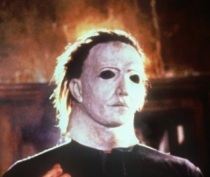Just a glance at my most-used tags lets me know that I tend to talk about the Halloween films a lot. But seeing as how I did a “Franchise Highs and Lows” piece for Friday the 13th on a Friday the 13th, I just couldn’t let October 31st come to pass without giving the Halloween franchise the same treatmeant – so let’s get to it!
HIGHS
 Halloween (1978) – The first and still the best. It kick-started the modern slasher genre and set the template that would be used by countless followers. In the hands of writer-director John Carpenter, a simple story of a masked killer (Michael Myers) stalking three girls in the peaceful suburb of Haddonfield, Illinois became a chilling tale of suspense and terror. Add in perfect performances by Jamie Lee Curtis as the definitive final girl, Laurie Strode and Donald Pleasence as Dr. Loomis, Michael’s determined and slightly off-kilter
Halloween (1978) – The first and still the best. It kick-started the modern slasher genre and set the template that would be used by countless followers. In the hands of writer-director John Carpenter, a simple story of a masked killer (Michael Myers) stalking three girls in the peaceful suburb of Haddonfield, Illinois became a chilling tale of suspense and terror. Add in perfect performances by Jamie Lee Curtis as the definitive final girl, Laurie Strode and Donald Pleasence as Dr. Loomis, Michael’s determined and slightly off-kilter psychiatrist and you have a modern-day classic.
psychiatrist and you have a modern-day classic.
The Original Mask – take one William Shatner “Captain Kirk” mask, paint it white, and voila – the terrifying non-face of evil is born.
Halloween Theme – It’s safe to say that the tension and scares in Halloween would have been a lot less effective if it were not for the inclusion of John Carpenter’s score. His main theme has also become so iconic that it’s the horror movie version of the Bond theme, appearing in one form or another in every film in the Halloween franchise (which was also a sly way for the producers of the non-Carpenter sequels to get his name on the credits).
Halloween 4 and Halloween H20
The original Halloween series was resurrected not once, but twice – and both times it rose from the dead to give fans exactly what they wanted – a return to that classic “Halloween feel”. Halloween 4 returned Michael Myers to the franchise after the Myers-less Halloween III and Halloween H20 brought Jamie Lee Curtis back into the fold after a 17 year absence – ignoring the nonsense wrought by Halloween 6 (more on that below) and picking up the story after Halloween II (which I explained in more detail here).
This Moment*

Halloween 4 Opening Credits – This sequence has an understated genius. It’s nothing flashy or ground-breaking – just some bleak, countryside Halloween-themed images that get more and more sinister looking as the sun sets and the score build ominously. Definitely sets the tension for the film right from the start.
LOWS
Halloween III: Season of the Witch – this non-canon sequel was an attempt at taking the franchise into an anthology-type direction, but with absolutely no connection to the previous films at all (it took place in the “real” world, where Halloween was only a movie) the “III” added to the title only served to confuse and anger movie-goers who went in expecting Michael Myers and instead got an evil, cult-worshipping mask manufacturer bent on killing a ton of kiddies with his deadly masks.
Halloween: The Curse of Michael Myers – the sixth Halloween entry tried to introduce an over-wrought cult mythology to explain the motivations of Michael Myers. Constant studio interference to the final cut of the film resulted in a bootleg director’s cut surfacing on dvd (aka Halloween 666) with almost 45 minutes of cut footage and storylines. With or without it though, the film was still a jumbled mess full of questionable continuity and plot holes a-plenty.
Mask Continuity – Unlike fellow franchisers Jason (Friday the 13th) and Ghostface (Scream), Michael Myers didn’t wear a mass-produced mask. And that became a problem with each successive Halloween film as they tried their best to replicate the original. They met with varying degrees of success, with the worst of the lot definitely being Halloween 5’s flat-ironed hair/flared neck version.
Busta Rhymes – With no more Dr. Loomis in the storyline, Halloween: Resurrection enlisted rapper Busta Rhymes to go mano a mano with Michael Myers. Playing Freddie, a kung fu loving reality tv producer, Rhymes used his velociraptor maw to chew scenery with gusto and make viewers long for the days of the dearly departed Donald Pleasence.
Rob Zombie’s Vision – while Zombie indeed brought new ideas to his 2007 take on Halloween (detailed more here), his “vision” also included changing Haddonfield to a town that was mostly dirty and unappealing and filled with mostly dirty, unappealing (and not to mention foul-mouthed) people – not doing a lot for empathy there. And by Halloween II (2009), Laurie Strode had become so insufferable you were almost rooting for Michael to actually kill her this time around. And as for Michael – he was turned into such a mindless rampaging beast that it almost seemed like a parody (seriously, when you have Michael Myers foot-stomping someone’s head until it is a literal mashed, bloody pulp, the result isn’t scary, it’s just revolting).
But, just to end on a good note, I leave you with this – a decidedly different take on a classic scene – Happy Halloween!
*gif via Popobawa



